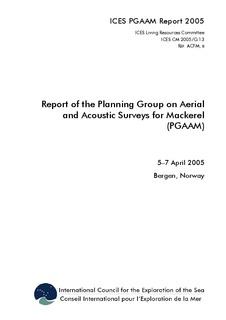| dc.description.abstract | Mackerel are widely distributed in the North-East Atlantic. Many countries fish for mackerel
and the Working Group on the Assessment of Mackerel, Horse Mackerel, Sardine and Anchovy
(WGMHSA) assembled the distribution of commercial catches. However the distribution
of commercial catches should be interpreted with caution due to environmental factors,
stock size, and quota/area limitations for the participating nations (some countries cannot fish
in the different national EEZs).
The WGMHSA assessment of the North-East Atlantic mackerel is currently dependent on a
single fishery independent estimate of biomass, derived from the ICES Triennial Mackerel
and Horse Mackerel Egg Surveys. This is only available once every three years and makes the
assessment increasingly insecure with elapsed time since the last survey. However, the various
annual research surveys by different countries have verified that there is an even wider distribution
of mackerel than that indicated by the commercial fisheries. All surveys have the potential
to deliver information on the distribution and abundance of mackerel. However, the
surveys cover only part of the known distribution area and consequently have not been able to
deliver a valid stock estimate or complete distribution map.
The Planning Group on Aerial and Acoustic Surveys for Mackerel (PGAAM) was established
during the WGMHSA meeting in September 2001 with the main purpose of coordinating a
number of surveys on pelagic species that can provide the information on the distribution and
abundance of mackerel (Section 1, 5, 6, 7, 8).
The main objectives of PGAAM are to provide the distribution of mackerel and biomass/
number indices that may be used by WGMHSA in future assessments. Furthermore, it
aims to collate information on the hydrographic and plankton conditions of the Norwegian Sea
and adjacent waters to describe how feeding and migration of mackerel are influenced by this. The PGAAM met to coordinate vessels from appropriate countries which can collaborate with
the Russian aerial surveys in the Norwegian Sea (Section 5), to coordinate Scottish and Norwegian
acoustic surveys in the Viking Bank area (Section 6), to coordinate Spanish, Portuguese
and French acoustic surveys (Section 7). Mackerel do not possess a swim bladder. As a
result, they are poor reflectors of sound and have a low target strength (TS), so it’s very difficult
to use the acoustic assessment. The PGAAM has tried to utilize the findings of the EU
SIMFAMI project to provide tools to identify mackerel echo-traces (Section 2, 3) as well as to
develop protocols and criteria to ensure standardisation of all sampling tools and survey gears
(Section 4).
The PGAAM made a list of the surveys in the North-East Atlantic not targeted at mackerel,
but with the potential of collecting mackerel data to provide indices of mackerel abundance.
Some surveys followed the PGAAM recommendations and collected data, and passed them to
PGAAM (Section 8).
Norway has surveyed the mackerel acoustically during the autumn for the last six years and
PGAAM recommends that WGHMSA consider the use of these data as a relative index in the
assessment as well the joint Scottish and Norwegian autumn surveys on mackerel. The Russian
and Norwegian summer surveys should also be considered as tuning indices for the assessment
of the mackerel stock (Section 5, 6, 10).
Commencing from 2004, the ICES advice has changed in several aspects as well as the approach
to the investigations. A new Ecosystem-based approach to the fishery advice/
management has begun. Near collaboration between the various surveys and descriptions
of the ecosystem as a whole (including most of the marine exploration aspects) are requested
today. Many of the issues carried out by PGAAM, PGNAPES and PGHERS overlap today, and therefore it is felt that the PGAAM duties are now finalized for the present time and the
relevant references be passed onto the PGNAPES and PGHERS starting from 2006 (Section
9). | en |
